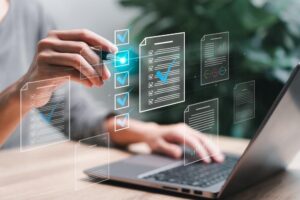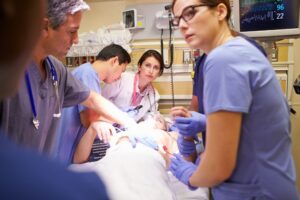Simulation Program
A simulation program is an educational initiative that allows learners to hone in on and practice new healthcare skills, all while improving patient safety outcomes and ultimately reducing medical errors. The primary purpose of clinical simulation is to deliver high-quality, realistic simulated clinical learning experiences in both discipline-specific and interprofessional environments to prepare for an evolving healthcare system. Another goal of healthcare simulation programs is to improve the competence and performance of specific simulation-based practices. This is achieved through the development of critical thinking and applying effective teamwork and communication strategies.
Healthcare simulation programs often exist across university degree programs and within medical facilities to assist in the training of learners and professionals alike. While simulation programs may encompass different focuses/disciplines and utilize individualized solutions and technology, there are several components that tend to remain consistent. For example, most medical simulation programs rely on manikins, moulage, virtual reality, standardized patients (SPs), and other clinical solutions to best convey healthcare simulation principles.
An example of a simulation program discipline is high fidelity team simulation. This core competency learning can include the creation of realistic scenarios that allow learners to improve their team dynamics and communication skills in high-risk, low-frequency, and life-threatening situations. High fidelity and reinforcing effective communication strategies during everything from standardized Pediatric and Adult Advanced Life Support scenarios to the most complex and unique scenarios.
Sponsored Content:
Other disciplines can include technical skills development training, SP encounters, healthcare simulation faculty development, in-situ systems evaluation, mock codes, and more. Other topics that can be covered within a simulation program can be audio-visual recording, remote simulation, moulage, virtual reality training, and new department training, as well as others.
The size of a sim program largely depends on the university of the facility through which it is offered. Some clinical simulation programs accept small numbers of learners, ranging from just a few to upwards of 10 or 15, while others have much greater enrollment capacities (over 20). Similarly, the type of simulation program offered at a particular institution or facility is dependent on a number of factors. For example, if a healthcare simulation center is affiliated with a particular university, clinic, or hospital – and what that facility feels professionals entering the field need to be trained on the most.
Further, simulation programs today may be completed both in-person and virtually. This is because many healthcare simulation centers now offer their entire simulation programs and included clinical simulation courses online to make them more accessible to a greater number of learners and professionals. Being able to provide simulation program courses virtually became especially important during the COVID-19 pandemic when in-person learning was no longer an option for most institutions.
At these institutions and facilities, healthcare simulation programs are typically run by clinical simulation educators who work to ensure that all curriculum goals are met. Standardized patients can be employed to assist with the healthcare simulation scenarios and experiences to increase realism, and a simulation center director may oversee the simulation program’s entirety.
Sponsored Content:
Remember, a simulation program differs from a simulation center in that a simulation center is the facility in which a clinical simulation program and the included clinical skills activities can take place. Additionally, a simulation program is different from a simulation lab, because the lab is the physical space where simulation lessons and learning activities can be performed. A clinical simulation lab is often where medical simulation equipment and technology are housed for use and security.
Simulation Program Examples
Winter Institute for Simulation Education and Research (WISER): WISER is a world-class multidisciplinary healthcare simulation training and research facility out of UPMC. The institute offers several simulation programs, including the fellowship program that is designed for individuals that would like to participate in a one to two-year curriculum that includes the WISER Foundation, electives, workshops, course observations, and a scholarly project. Another program, the preceptorship program, is designed for individuals that would like to participate in a structured one to 11-month curriculum that includes the WISER Foundation, electives, workshops, and course observations. Additionally, the professional development program was developed for individuals that would like to participate in a structured curriculum that includes the WISER Foundation, electives, and course observations.
Cedars Sinai Women’s Guild Simulation Center for Advanced Clinical Skills: The Women’s Guild Simulation Center for Advanced Clinical Skills is an immersive environment equipped with the latest in patient simulators and medical devices, and replicates the reality of professionals working together. The Center has a variety of programs, such as the Clinical Scholars Program, which helps fulfill Cedars-Sinai’s fundamental mission of service to the community by educating and training healthcare professionals and medical research personnel. Then, the healthcare immersion program for high school students allows for real hands-on experiences, including being able to:
- Experience managing a sick patient’s airway
- Visit a fully working operating room and experience a surgical simulation
- Understand how to gain vascular access by passing a needle into a bone
- Use virtual surgical simulators to practice hands-on surgery
- Practice and develop your resuscitation skills
Cedars-Sinai also provides a one-year clinical laboratory scientist hands-on clinical experience in conjunction with California State University, Dominguez Hills (CSUDH), and California State University, Los Angeles (CSULA). The program includes 32 hours per week of laboratory rotations at Cedars-Sinai, as well as six to eight hours of classroom instruction provided by the schools each week. Learn more about simulation programs by reading the articles below.
Simulation Program Education Latest News

Developing a Collaborative IPE Criminal Justice Nursing Simulation Scenario

How to Manage Healthcare Simulation Program Workloads

How to Network in Clinical Simulation for Increased Program Success

First Impressions: How to Design the First Clinical Simulation Experience

How to Introduce a Completely New Clinical Simulation Modality

How to Fill-in for the Role of Clinical Simulation Technician

How to Develop a Healthcare Simulation Program That Sells Itself

A Guide to Enhancing Healthcare Simulation Through Gamification

How to Restart a Healthcare Simulation Program

Launch the New Year with Live CE/CME Healthcare Simulation Webinars This Month!

Best Nursing Simulation Webinars of 2023

How to Complete Healthcare Simulation Program Annual Reviews
Sponsored Content:


















